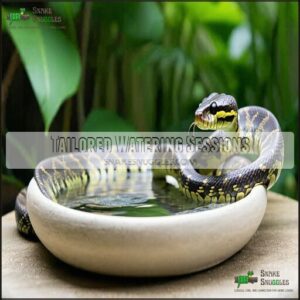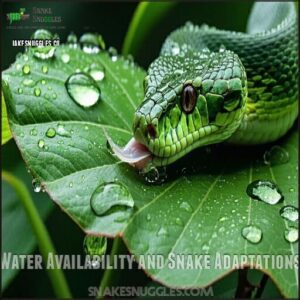This site is supported by our readers. We may earn a commission, at no cost to you, if you purchase through links.

Instead of sipping like you might from a glass, many snakes use their specially adapted jaws and grooves in their mouths to draw water in through capillary action, almost like a sponge.
Some even collect droplets on their scales during rain or mist, drinking them drop by drop.
In captivity, they’ll often benefit from shallow bowls or misting systems to stay hydrated.
Without enough water, snakes can struggle with shedding skin or digestion.
Their methods might seem unusual, but they’re perfectly suited to life in the wild—or your care, using specially adapted jaws.
Table Of Contents
Key Takeaways
- Snakes drink water using a sponge-like structure in their mouths, relying on capillary action to draw water efficiently.
- They also get hydration from prey and environmental moisture, like rain or dew, depending on their habitat.
- Proper hydration is crucial for snakes to shed skin effectively, maintain digestion, and avoid health issues like dehydration.
- In captivity, fresh water or misting systems help meet your snake’s hydration needs based on species and behavior.
Snake Water Consumption
You’ll be surprised to learn that snakes use a remarkable sponge-like structure in their mouths to drink water, with specialized skin folds that create suction through capillary action.
Unlike mammals, they don’t lap water but instead compress and release these specialized tissues to draw moisture into their bodies, an efficient adaptation that helps them survive in various habitats.
Unique Drinking Mechanisms
You’ll be amazed by how snakes drink water – their methods are nothing like our own!
Snakes defy expectations with their incredible drinking methods, using specialized sponge-like structures to absorb water efficiently without a single lap.
Unlike mammals that lap water, snakes have evolved unique drinking mechanisms that rely on specialized oral structures and movements.
- The sponge mechanism involves compressing and releasing tissue folds
- Capillary action draws water into the mouth against gravity
- Head pressure from jaw muscles creates essential suction
- Snake jaw anatomy facilitates efficient water intake without lapping
- The entire snake drinking process occurs without tongue involvement
These specialized snake drinking mechanisms perfectly illustrate how evolution has solved hydration challenges in remarkable ways. Snakes also utilize throat expansion to create negative pressure for drinking, which is a key aspect of their unique drinking mechanisms and evolutionary adaptations.
Sponge-Like Mouth Structure
You’ve probably wondered how snakes drink without conventional lips.
Inside of a snake’s mouth, the lower jaw contains specialized folds of soft tissue that function like a natural sponge.
When these jaw folds compress, the tissue gaps create suction for water absorption.
| Snake Mouth Feature | Function | Drinking Process |
|---|---|---|
| Jaw Folds | Creates spongelike structure | Expands when relaxed |
| Tissue Gaps | Acts as sponge holes | Fills with water |
| Head Pressure | Generates suction | Controls water flow |
| Muscle Action | Compresses tissue | Squeezes water inward |
| Lower Jaw | Houses drinking mechanism | Directs water to throat |
Capillary Action in Drinking
Beyond the sponge-like structures in a snake’s mouth, capillary action plays a fascinating role in how snakes drink water.
When a snake’s specialized skin folds make surface contact with water, the liquid moves through these micro-structures without external force.
Similar to water climbing up a paper towel, water tension pulls moisture through scale grooves and into the snake’s mouth.
This skin fold absorption method complements their unique drinking methods, utilizing water tension to facilitate hydration.
Do Snakes Drink Water
Yes, snakes do drink water, though their drinking frequency varies considerably between species and individuals.
Unlike mammals, snakes don’t lap up water with their tongues; instead, they use a specialized sponge-like structure in their lower jaw. You’ll rarely witness snake water intake in the wild, as many species are secretive drinkers.
Some snakes have specific water preferences—desert-dwelling species might drink less frequently, relying primarily on moisture from prey, while aquatic snakes drink more regularly.
In captivity, some snakes may require assisted drinking, especially if dehydrated or stressed. Contrary to popular belief, a snake’s tongue plays no role in hydration; it’s purely for scent collection.
Observed behaviors include submerging their heads, creating suction with jaw movements, or drinking droplets from surfaces. All healthy snakes need water access, regardless of how infrequently they’re seen drinking.
Snake Hydration Methods
You’ll be surprised to learn that snakes use a unique sponge-like structure in their mouths to absorb water rather than lapping it up like other animals.
Their specialized lower jaw contains folds of soft tissue that create suction when compressed and released, allowing them to drink efficiently without needing to tilt their heads, utilizing a unique mechanism for water absorption.
Misters as an Innovative Solution
Misters have become a game-changer for snake hydration in captivity.
These systems create fine water droplets that mimic rainfall, maintaining proper humidity levels in enclosures.
Automatic misting systems guarantee consistent moisture without constant monitoring, making them ideal for screen cages and arboreal species that primarily drink from water droplets on leaves.
Though not suitable for all snakes (as they can oversaturate tanks), they’re especially beneficial for rainforest dwellers that rarely drink from standing water.
Maintaining proper misting schedules can help guarantee healthy scale shedding, which is crucial for the overall health of the snakes, and proper humidity levels are essential for their well-being, ensuring a healthy environment.
Tailored Watering Sessions
How can you guarantee your snake stays properly hydrated? Customized watering sessions address your reptile’s individual needs based on species, size, and habitat requirements.
While some snakes drink daily, others have different drinking frequency patterns. Consider water temperature (room temperature is ideal), session duration, and presentation methods when offering water.
A suitable snake water dish is essential for providing fresh water. Observing your snake’s drinking behavior helps you understand their unique water consumption habits and adjust accordingly, ensuring you can provide the best hydration for your pet, and understand their individual needs.
Environmental Humidity and Hydration
Humidity acts as nature’s water cooler for your snake’s hydration needs.
You’ll find that proper environmental humidity supports reptile hydration even when direct drinking isn’t observed. Different species have unique requirements—desert snakes thrive in drier conditions while arboreal species need higher humidity levels.
Maintaining appropriate moisture in the enclosure promotes successful shedding, prevents respiratory health issues, and supplements hydration through skin absorption, complementing your snake’s water consumption habits.
Accurate readings require a reliable humidity gauge to ensure successful shedding and overall health, which is crucial for your snake’s well-being, and reptile hydration is key to a healthy pet.
Snake Dehydration Risks
You’ll notice your snake’s health quickly deteriorate if it doesn’t get enough water, with problems ranging from difficult shedding to serious digestive issues.
If you spot wrinkled skin, sunken eyes, or your snake refusing food, it’s likely suffering from dehydration and needs immediate attention.
Impact on Health and Well-being
When a snake becomes dehydrated, its overall health rapidly deteriorates, affecting multiple bodily systems.
You’ll notice behavioral changes like lethargy and reduced tongue-flicking—key health indicators that shouldn’t be ignored.
Lethargy and reduced tongue-flicking are silent red flags, signaling dehydration and the need for immediate care to keep your snake healthy.
Poor hydration effects include sunken eyes, wrinkled skin, and decreased muscle tone.
Without proper drinking frequency and water quality, your snake’s immune system weakens, potentially leading to snake illness or even death if severe dehydration persists, which can be indicated by lethargy and reduced tongue-flicking.
Difficulty Defecating and Shedding
Two critical health issues signal dehydration in your snake: difficulty defecating and incomplete shedding.
When your reptile friend lacks proper hydration, it can’t eliminate waste effectively, resulting in constipation and potential impaction risks. You’ll notice dry feces or infrequent elimination.
Similarly, retained skin patches and eye caps occur when there’s insufficient moisture for proper shedding. Using a quality shedding product can also assist in this process.
A warm soak for 10-15 minutes can address both problems while increasing environmental humidity prevents future issues, which is a critical step in maintaining your snake’s health, and ensuring proper hydration is key to preventing these issues, and can help with effective shedding.
Signs of Dehydration in Snakes
Vigilance is your best defense against snake dehydration. You’ll notice several warning signs: sunken eyes, skin wrinkling (especially visible as loose folds), and lethargy are immediate red flags.
Watch for sticky mucus around the mouth, difficulty shedding, and unexplained weight loss. Your snake might also refuse food and show abnormal behavior.
Dry, wrinkled skin is a key indicator of dehydration and requires attention. These dehydration signs require prompt attention to restore proper snake health and prevent serious complications, highlighting the importance of vigilance and addressing snake dehydration.
Snake Water Sources
You might be surprised to learn how snakes find water in the wild and in captivity.
From collecting droplets on specially adapted scales to sipping from water bowls, snakes have fascinating ways of staying hydrated.
In The Wild and in Captivity
Out in nature or your home, hydration works differently.
In the wild, snakes drink water rarely, relying on prey moisture or puddles. In captivity, they need consistent water sources to stay healthy.
Assisted drinking might help stressed snakes. Water rights overallocation impacts water availability for all species.
Keep in mind:
- Wild hydration varies.
- Captive drinking needs monitoring.
- Water frequency depends on species.
- Hydration impacts shedding.
- Freshwater is always a winner, and understanding hydration needs is crucial.
Specialized Scales for Water Collection
Rattlesnakes turn their scales into tiny water collectors, revolutionizing survival in arid deserts.
Scale microstructures trap droplets, keeping water in place for easy absorption. This incredible scale morphology showcases evolutionary advantages that guarantee hydration where water’s scarce.
By flattening their bodies, baby rattlesnakes maximize water harvesting immediately after birth, proving how snake adaptations ingeniously reshape drinking habits and hydration methods for sustainability. This behavior highlights the evolutionary advantages of such adaptations in ensuring the snakes’ survival.
Water Availability and Snake Adaptations
In terms of water availability, snake adaptations are remarkable.
Many rely on prey hydration in arid habitats, while others demonstrate curious drinking habits.
Behavioral variations like drinking frequency depend on habitat influence.
Some absorb water from rainfall, utilizing snake water sources like specialized scales.
These unique snake hydration habits prove how resilient they’re in diverse environments, maximizing every drop of moisture.
Frequently Asked Questions (FAQs)
How often do snakes drink water?
Snakes drink water at varying intervals, often depending on their species, habitat, and diet.
Some drink daily, others rarely, getting moisture from prey.
Watch closely—snakes can be pretty sneaky when quenching their thirst!
Do snakes get thirsty?
Snakes do get thirsty, though they’re pros at hiding it.
Their bodies signal the need for water, prompting them to drink from available sources or absorb moisture from prey, keeping themselves stealthily hydrated.
Which animal doesn’t drink water?
Like a camel stores fat in its humps, the kangaroo rat doesn’t drink water.
It cleverly gets moisture from food and survives by producing water internally during digestion, a fascinating desert adaptation for survival.
How long can snakes go without water?
Depending on species and conditions, snakes can go weeks without water, relying on moisture from prey.
However, prolonged dehydration harms their health, so provide fresh water regularly to keep your slithery friend happy and hydrated.
Do snakes absorb water?
Imagine a sponge soaking up water—that’s how snakes absorb it too.
They use soft tissue folds near their lower jaws, drawing water through capillary action, a clever adaptation especially useful in dry environments.
How do snakes drink water?
You might find it fascinating that snakes use a sponge-like structure in their mouths to drink.
Their jaw muscles squeeze and release, creating suction that draws water in, kind of like sipping through an invisible straw.
Do snakes need water?
Yes, snakes need water to stay healthy.
They rely on drinking or absorbing water from their environment to maintain hydration.
Even desert snakes depend on moisture from prey or dew for survival.
Do snakes drink a lot?
Snakes don’t drink a lot.
They hydrate efficiently, often absorbing water through sponge-like structures in their mouths.
Some species drink rarely, relying on prey or humidity, while others sip more regularly when water’s available, using their ability to hydrate efficiently.
Do pet snakes drink water?
It’s funny how a creature that swallows prey whole still needs a sip now and then.
Pet snakes drink water, usually by drawing it into their mouths like a sponge, staying hydrated even in captivity.
Do Snakes get water from food?
You’re right to wonder—snakes get a good chunk of their water from food, especially prey like mice or frogs.
Their juicy meals supply essential hydration, minimizing their need for drinking water outright.
Conclusion
While snakes mightn’t throw back a glass of water like we do, their unique drinking methods are marvelously adapted to their needs.
Whether using capillary action, their sponge-like mouth structure, or even scales to collect droplets, snakes stay hydrated in ways that suit their environment.
So, do snakes drink water? Absolutely. From mist systems to shallow bowls in captivity, or rain in the wild, hydration is key to their health, helping them shed skin and digest with ease.














